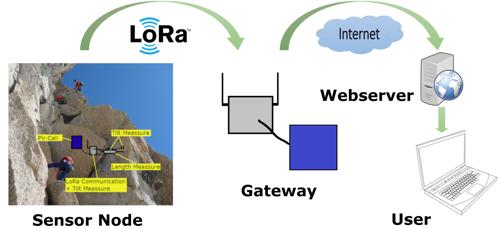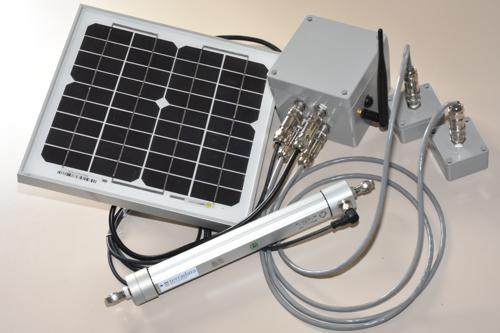Rock Monitoring in climate change and global warming context
- Degree programme: BSc in Elektrotechnik und Informationstechnologie
- Author: Andreas Zybach
- Thesis advisor: Prof. Dr. Andrea Ridolfi
- Expert: Ing. civ. dipl. FPE Cédric Vuilleumier
- Year: 2020
We present a monitoring system enabling the detection and measurement of movements in rock walls and mountains. Based on a very low power wireless sensor network approach, the system uses accelerometers to measure tilt and rotation, a crackmeter to measure crack displacement, and it implements LoRa technology to transmit data and alarms. Its design and implementation comply with harsh operating conditions, such as those encountered in high altitude alpine environments.
Motivation
Climate change and global warming are responsible for high variation of temperature in short times, and periods of exceptionally high temperature at high altitudes. The direct consequences are a high stress on rock structures (mountains, cliffs) and the melting of the Permafrost, causing severe rock falls (e.g., 2019 Mattherhorn VS, 2018 Col de la Forclaz VS, 2017 Pizzo Cengalo GR, to mention a few). Therefore, the monitoring of rock movements in order to estimate the degree of danger of rock falls in key locations (e.g., roads, populated valleys, frequented alpine routes, and high alpine environments) is of foremost importance, both for safety and research purposes. Existing Commercial devices are limited to the 1D measurement of crack gaps using a crackmeter. The 3D movement monitoring prototypes previously developed at BFH were far away from being optimal, operational, and usable in alpine environments.
Wireless Sensor Network Concept
The developed prototype of 3D rock movement monitoring system follows a very low power sensor network approach and has the following key features:
- Power autonomy using a small solar panel and a rechargeable battery;
- Very low power consumption using LoRa radio transmission, dedicated hardware on a self developed board, efficient smart management of data transmission and alarm generation;
- Casing and components fitted for a long term installation on a high alpine environment (4000 m);
- Modular sensors enabling different monitoring scenarios;
It is composed of
- Main Board: LoRa Radio Module with a Microcontroller, Memory, External Sensor I2C Interfaces, Internal Accelerometer, Lead Acid Battery (low temperature) and Battery Management.
- External Sensorboards: Accelerometer and I2C Interface
- External ForaPot Crackmeter: Standard linear potentiometer used for rock movement monitoring in harsh environments.
The main board can be used alone (to measure the tilt and rotation of the rock it is fixed on), or in combination with one or two accelerometers, and / or the crackmeter. Such a modularity enables for several monitoring scenarios and extensions. Several monitoring systems can be combined using a LoRaWAN framework, therefore obtaining a Low Power Wide Area sensor network.
Results and Outlook
A new sensor node prototype has been developed. Functionalities of the monitoring system have been tested in laboratory. In collaboration with Dr. Ludovic Ravanel, geomorphologist at CNRS / Savoy University, we plan to install the prototype on Tour Ronde (3792 m) in the Mont Blanc Range, and to extensively test it.

